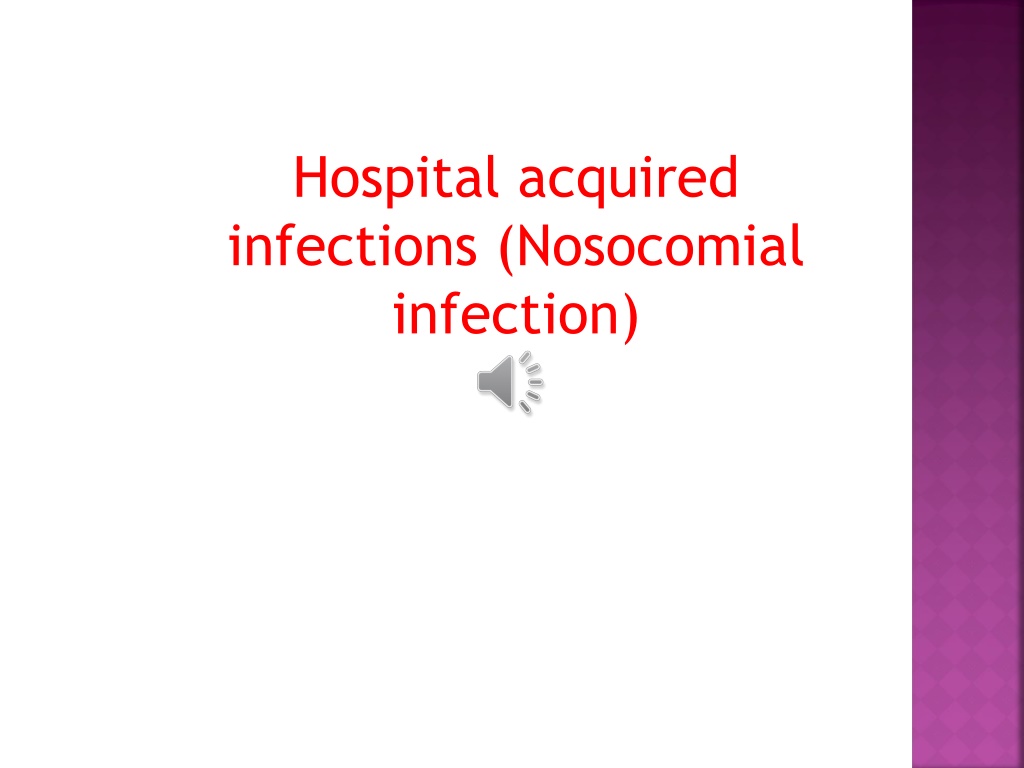Understanding Nosocomial Infections and Prevention Strategies
Nosocomial infections are microbial diseases that affect patients during hospital stays, with sources including patients, healthcare workers, and hospital environments. Investigations involve isolating organisms and typing them for efficient management. Prevention strategies include sterilization, health education, and standard precautions such as hand hygiene and proper waste disposal. Bacterial and viral vaccines play a crucial role in preventing infectious diseases in healthcare settings.
Download Presentation

Please find below an Image/Link to download the presentation.
The content on the website is provided AS IS for your information and personal use only. It may not be sold, licensed, or shared on other websites without obtaining consent from the author. Download presentation by click this link. If you encounter any issues during the download, it is possible that the publisher has removed the file from their server.
E N D
Presentation Transcript
Hospital acquired infections (Nosocomial infection)
Definition: Any microbial disease that affects the patients while admitted in a hospital. Types: 1- Surgical wound infections 2- Respiratory infections 3- G.I.T infections 4- U.T. Infections 5- Systemic infections Sources of infections: 1- Patients 2- Health care workers 3- Attendants 4- Hospital (air, water or equipment) 5- Blood or blood products 6- Instruments as cannulas
Investigations of Nosocomial infections: 1-Isolation of the organism from patients and suspected personnel. 2-Typing of both isolates by: - Biochemical typing Serotyping - Plasmid profile analysis Antibiogram - Restriction endonuclease analysis - PCR amplification
Prevention of Nosocomial infections: 1 Adequate sterilization and disinfection. 2- Health education programs for health care workers. 3- Follow up of surgical disciplines, frequent hand washing, gown and masks. 4- Follow the strategies that done by infection control committee. 5- Isolation of carriers, infective or immunocompromised patients.
Essential standard precautions used in the care of all patients : 1-Hand hiegine 2-Personal protective equipment 3-Aseptic techniques 4-Reprocessing of instruments and sterile devices 5-Environmental cleaning 6-Proper sharp and waste disposal
Some Bacterial vaccines Disease Vaccine Tuberculosis Live attenuated vaccine (BCG) Epidemic cerebrospinal meningitis Polysaccharide capsules of types A, C, Y and W135 Polysaccharide capsules Pneumococcal pneumonia Alum precipitated toxoid Diphtheria Toxoid Tetanus Killed vaccine Whooping cough Diphtheria, Tetanus and Whooping DPT cough Enteric fever Killed vaccine ( T.A.B.)
Some viral vaccines: Disease Vaccine Poliomyelitis Live attenuated (Sabin) or Killed vaccine (salk) Influenza Live attenuated or killed vaccine Measles, Mumps and rubella Live attenuated vaccine (MMR) Hepatitis B HBsAg- Recombinant DNA Vaccines required for children Age 1st month Vaccine BCG (Tuberculosis) 2nd month DPT, Sabin and HBV 4th and 6th months DPT, Sabin and HBV 15th month MMR 4 -6 years DPT, Sabin and MMR
Table of Vaccines that are recommended for HCP Vaccine Indication Vaccine/Route/Schedule Booster dose Hepatitis B All Health care staff 3 doses IM. 0, 1 month, 6 Not recommended months Td Tetanus Persons without a history or an 3 doses IM Every10 year If exposed to a dirty unknown history 0, 1-2 months, 6 months wound and last booster dose is > 5 years, give booster Rubella Un-immunized women of child- Single dose IM or SC bearing ag




























